2000 FORD E-250 trailer
[x] Cancel search: trailerPage 116 of 232
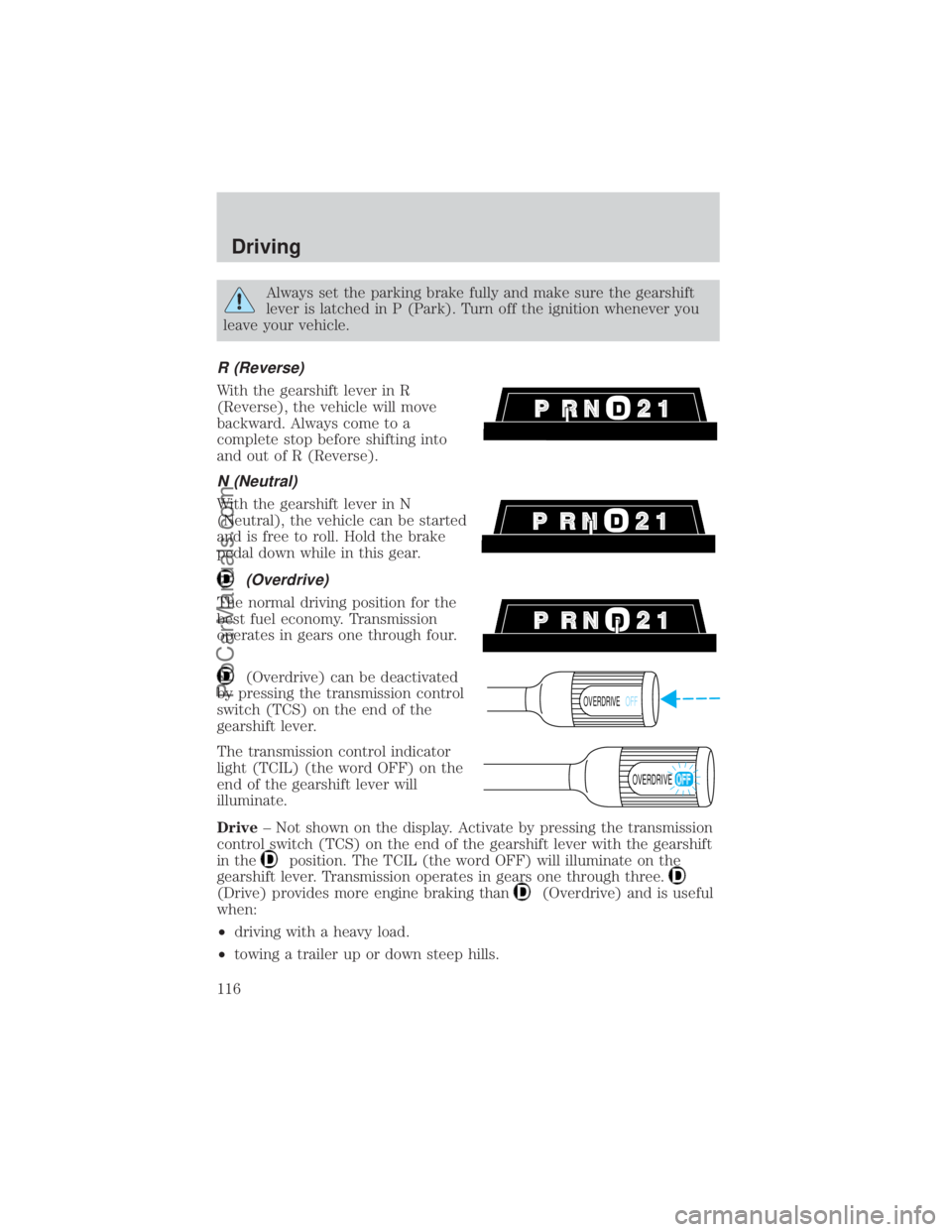
Always set the parking brake fully and make sure the gearshift
lever is latched in P (Park). Turn off the ignition whenever you
leave your vehicle.
R (Reverse)
With the gearshift lever in R
(Reverse), the vehicle will move
backward. Always come to a
complete stop before shifting into
and out of R (Reverse).
N (Neutral)
With the gearshift lever in N
(Neutral), the vehicle can be started
and is free to roll. Hold the brake
pedal down while in this gear.
(Overdrive)
The normal driving position for the
best fuel economy. Transmission
operates in gears one through four.
(Overdrive) can be deactivated
by pressing the transmission control
switch (TCS) on the end of the
gearshift lever.
The transmission control indicator
light (TCIL) (the word OFF) on the
end of the gearshift lever will
illuminate.
Drive± Not shown on the display. Activate by pressing the transmission
control switch (TCS) on the end of the gearshift lever with the gearshift
in the
position. The TCIL (the word OFF) will illuminate on the
gearshift lever. Transmission operates in gears one through three.
(Drive) provides more engine braking than(Overdrive) and is useful
when:
²driving with a heavy load.
²towing a trailer up or down steep hills.
OVERDRIVEOFF
OVERDRIVE
Driving
116
ProCarManuals.com
Page 117 of 232
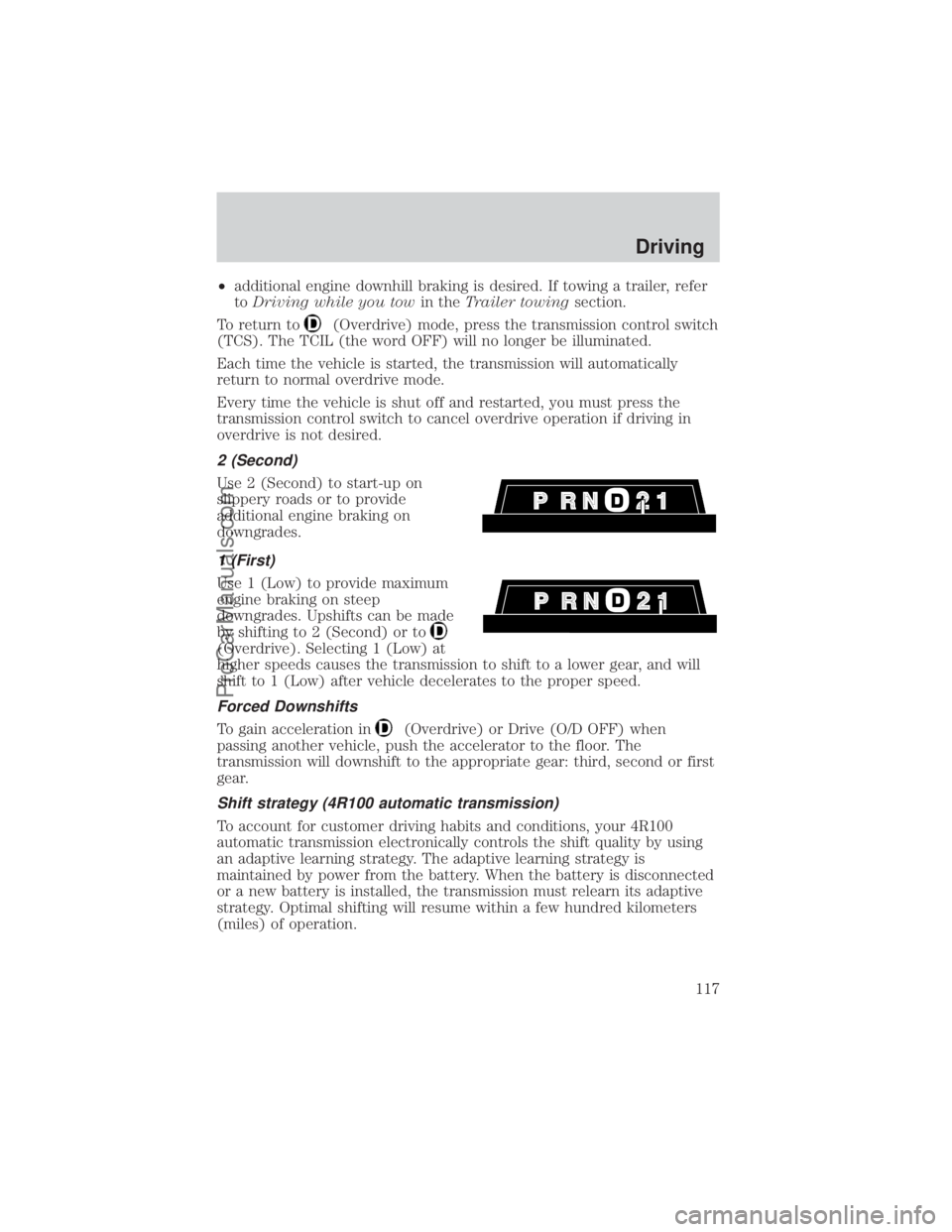
²additional engine downhill braking is desired. If towing a trailer, refer
toDriving while you towin theTrailer towingsection.
To return to
(Overdrive) mode, press the transmission control switch
(TCS). The TCIL (the word OFF) will no longer be illuminated.
Each time the vehicle is started, the transmission will automatically
return to normal overdrive mode.
Every time the vehicle is shut off and restarted, you must press the
transmission control switch to cancel overdrive operation if driving in
overdrive is not desired.
2 (Second)
Use 2 (Second) to start-up on
slippery roads or to provide
additional engine braking on
downgrades.
1 (First)
Use 1 (Low) to provide maximum
engine braking on steep
downgrades. Upshifts can be made
by shifting to 2 (Second) or to
(Overdrive). Selecting 1 (Low) at
higher speeds causes the transmission to shift to a lower gear, and will
shift to 1 (Low) after vehicle decelerates to the proper speed.
Forced Downshifts
To gain acceleration in(Overdrive) or Drive (O/D OFF) when
passing another vehicle, push the accelerator to the floor. The
transmission will downshift to the appropriate gear: third, second or first
gear.
Shift strategy (4R100 automatic transmission)
To account for customer driving habits and conditions, your 4R100
automatic transmission electronically controls the shift quality by using
an adaptive learning strategy. The adaptive learning strategy is
maintained by power from the battery. When the battery is disconnected
or a new battery is installed, the transmission must relearn its adaptive
strategy. Optimal shifting will resume within a few hundred kilometers
(miles) of operation.
Driving
117
ProCarManuals.com
Page 118 of 232
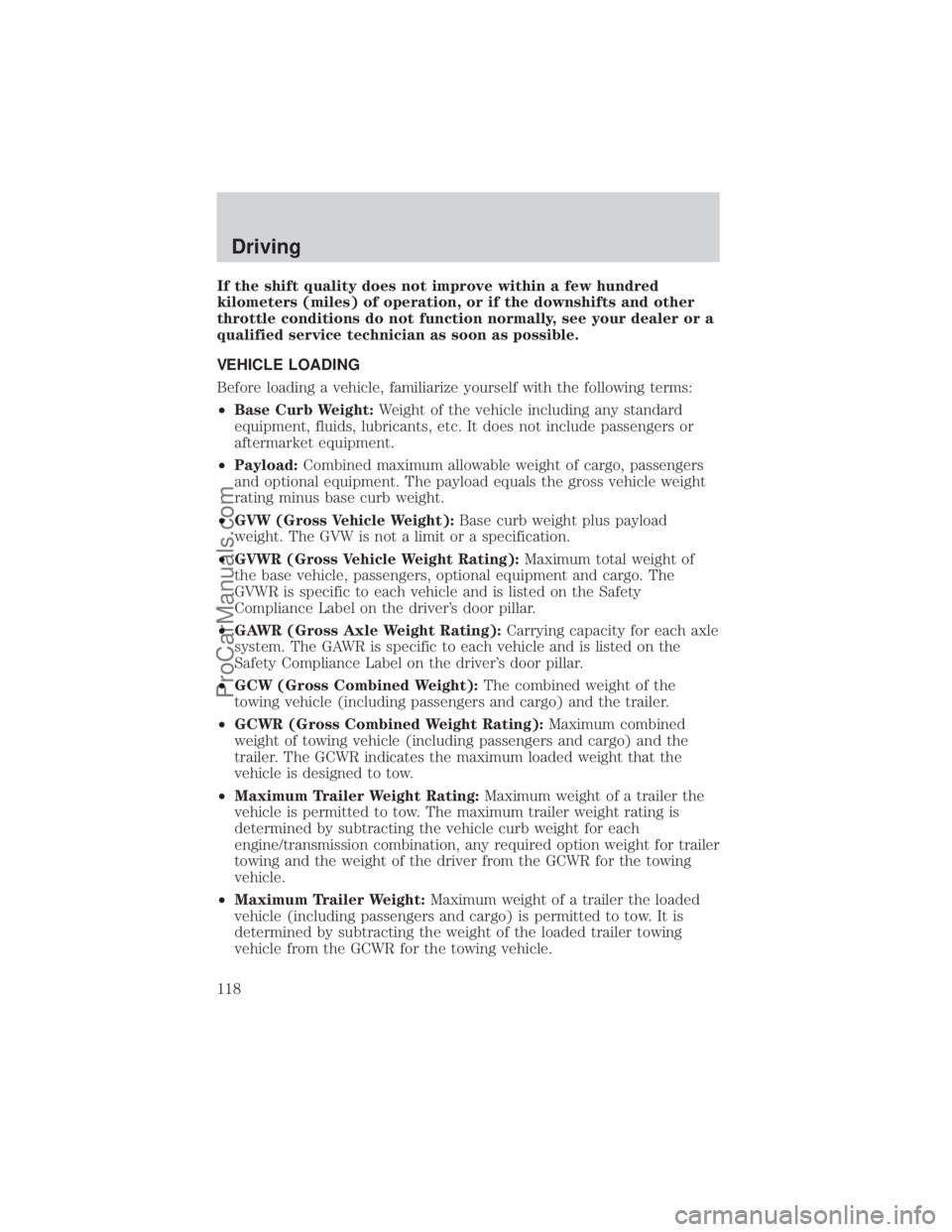
If the shift quality does not improve within a few hundred
kilometers (miles) of operation, or if the downshifts and other
throttle conditions do not function normally, see your dealer or a
qualified service technician as soon as possible.
VEHICLE LOADING
Before loading a vehicle, familiarize yourself with the following terms:
²Base Curb Weight:Weight of the vehicle including any standard
equipment, fluids, lubricants, etc. It does not include passengers or
aftermarket equipment.
²Payload:Combined maximum allowable weight of cargo, passengers
and optional equipment. The payload equals the gross vehicle weight
rating minus base curb weight.
²GVW (Gross Vehicle Weight):Base curb weight plus payload
weight. The GVW is not a limit or a specification.
²GVWR (Gross Vehicle Weight Rating):Maximum total weight of
the base vehicle, passengers, optional equipment and cargo. The
GVWR is specific to each vehicle and is listed on the Safety
Compliance Label on the driver's door pillar.
²GAWR (Gross Axle Weight Rating):Carrying capacity for each axle
system. The GAWR is specific to each vehicle and is listed on the
Safety Compliance Label on the driver's door pillar.
²GCW (Gross Combined Weight):The combined weight of the
towing vehicle (including passengers and cargo) and the trailer.
²GCWR (Gross Combined Weight Rating):Maximum combined
weight of towing vehicle (including passengers and cargo) and the
trailer. The GCWR indicates the maximum loaded weight that the
vehicle is designed to tow.
²Maximum Trailer Weight Rating:Maximum weight of a trailer the
vehicle is permitted to tow. The maximum trailer weight rating is
determined by subtracting the vehicle curb weight for each
engine/transmission combination, any required option weight for trailer
towing and the weight of the driver from the GCWR for the towing
vehicle.
²Maximum Trailer Weight:Maximum weight of a trailer the loaded
vehicle (including passengers and cargo) is permitted to tow. It is
determined by subtracting the weight of the loaded trailer towing
vehicle from the GCWR for the towing vehicle.
Driving
118
ProCarManuals.com
Page 119 of 232
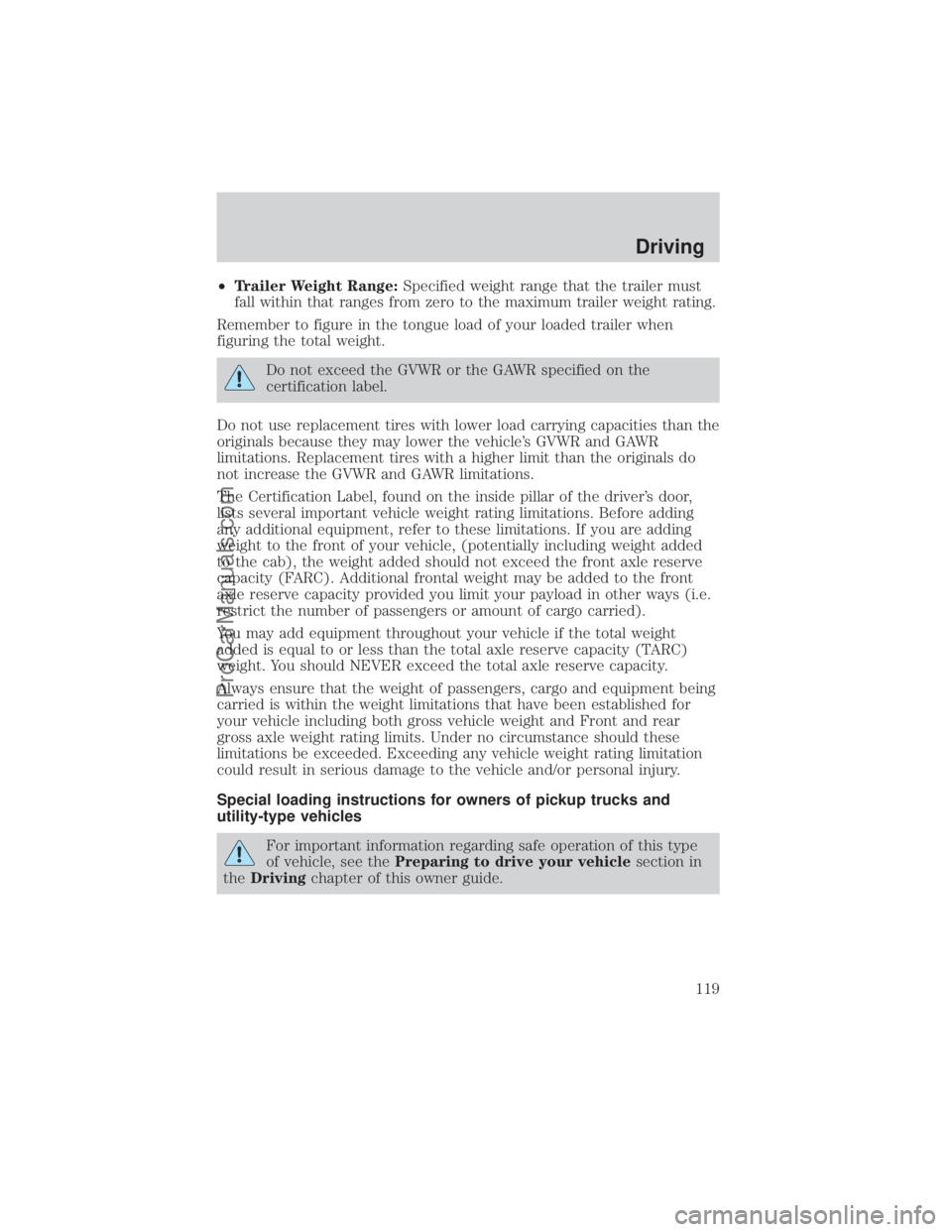
²Trailer Weight Range:Specified weight range that the trailer must
fall within that ranges from zero to the maximum trailer weight rating.
Remember to figure in the tongue load of your loaded trailer when
figuring the total weight.
Do not exceed the GVWR or the GAWR specified on the
certification label.
Do not use replacement tires with lower load carrying capacities than the
originals because they may lower the vehicle's GVWR and GAWR
limitations. Replacement tires with a higher limit than the originals do
not increase the GVWR and GAWR limitations.
The Certification Label, found on the inside pillar of the driver's door,
lists several important vehicle weight rating limitations. Before adding
any additional equipment, refer to these limitations. If you are adding
weight to the front of your vehicle, (potentially including weight added
to the cab), the weight added should not exceed the front axle reserve
capacity (FARC). Additional frontal weight may be added to the front
axle reserve capacity provided you limit your payload in other ways (i.e.
restrict the number of passengers or amount of cargo carried).
You may add equipment throughout your vehicle if the total weight
added is equal to or less than the total axle reserve capacity (TARC)
weight. You should NEVER exceed the total axle reserve capacity.
Always ensure that the weight of passengers, cargo and equipment being
carried is within the weight limitations that have been established for
your vehicle including both gross vehicle weight and Front and rear
gross axle weight rating limits. Under no circumstance should these
limitations be exceeded. Exceeding any vehicle weight rating limitation
could result in serious damage to the vehicle and/or personal injury.
Special loading instructions for owners of pickup trucks and
utility-type vehicles
For important information regarding safe operation of this type
of vehicle, see thePreparing to drive your vehiclesection in
theDrivingchapter of this owner guide.
Driving
119
ProCarManuals.com
Page 120 of 232
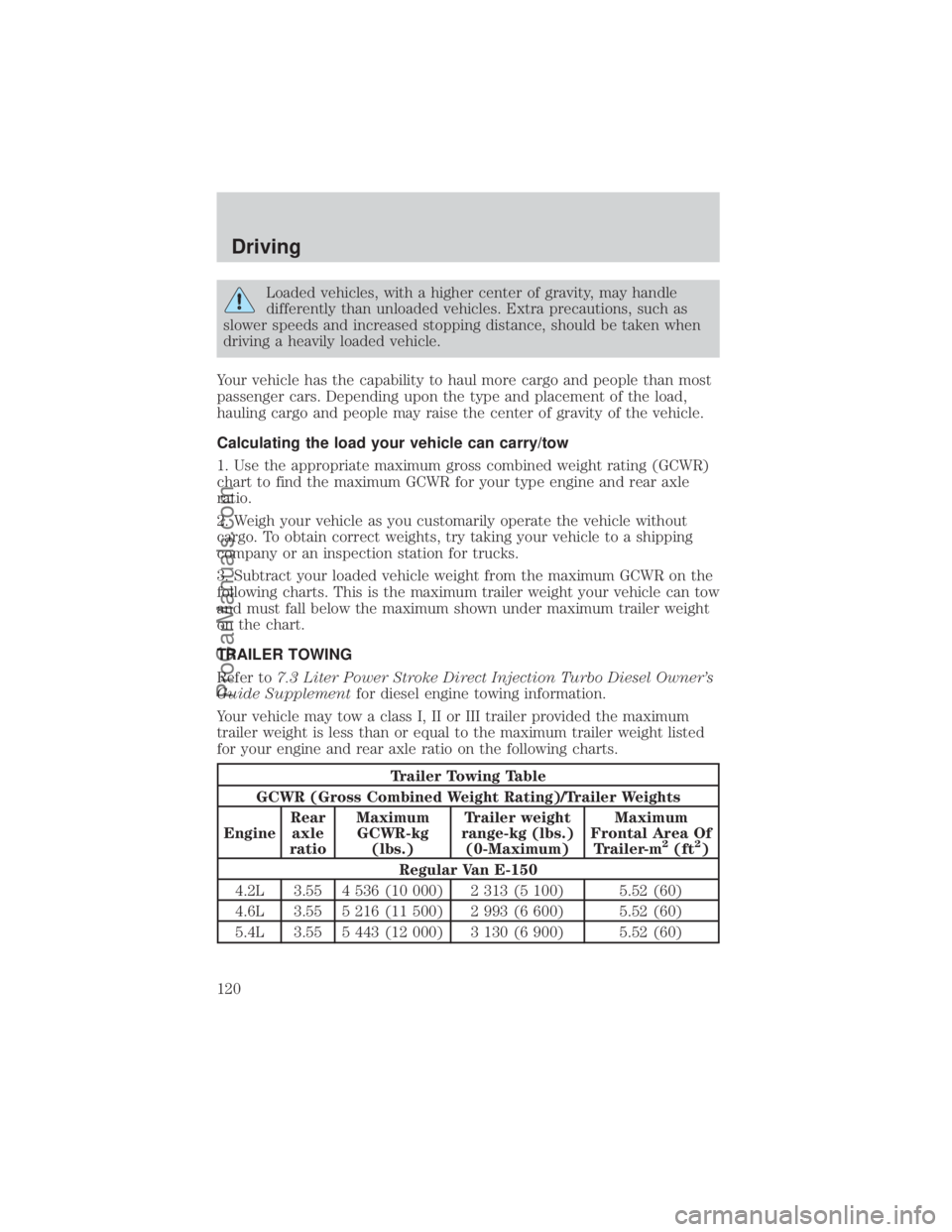
Loaded vehicles, with a higher center of gravity, may handle
differently than unloaded vehicles. Extra precautions, such as
slower speeds and increased stopping distance, should be taken when
driving a heavily loaded vehicle.
Your vehicle has the capability to haul more cargo and people than most
passenger cars. Depending upon the type and placement of the load,
hauling cargo and people may raise the center of gravity of the vehicle.
Calculating the load your vehicle can carry/tow
1. Use the appropriate maximum gross combined weight rating (GCWR)
chart to find the maximum GCWR for your type engine and rear axle
ratio.
2. Weigh your vehicle as you customarily operate the vehicle without
cargo. To obtain correct weights, try taking your vehicle to a shipping
company or an inspection station for trucks.
3. Subtract your loaded vehicle weight from the maximum GCWR on the
following charts. This is the maximum trailer weight your vehicle can tow
and must fall below the maximum shown under maximum trailer weight
on the chart.
TRAILER TOWING
Refer to7.3 Liter Power Stroke Direct Injection Turbo Diesel Owner's
Guide Supplementfor diesel engine towing information.
Your vehicle may tow a class I, II or III trailer provided the maximum
trailer weight is less than or equal to the maximum trailer weight listed
for your engine and rear axle ratio on the following charts.
Trailer Towing Table
GCWR (Gross Combined Weight Rating)/Trailer Weights
EngineRear
axle
ratioMaximum
GCWR-kg
(lbs.)Trailer weight
range-kg (lbs.)
(0-Maximum)Maximum
Frontal Area Of
Trailer-m
2(ft2)
Regular Van E-150
4.2L 3.55 4 536 (10 000) 2 313 (5 100) 5.52 (60)
4.6L 3.55 5 216 (11 500) 2 993 (6 600) 5.52 (60)
5.4L 3.55 5 443 (12 000) 3 130 (6 900) 5.52 (60)
Driving
120
ProCarManuals.com
Page 121 of 232

Trailer Towing Table
GCWR (Gross Combined Weight Rating)/Trailer Weights
EngineRear
axle
ratioMaximum
GCWR-kg
(lbs.)Trailer weight
range-kg (lbs.)
(0-Maximum)Maximum
Frontal Area Of
Trailer-m
2(ft2)
Regular Van E-250
4.2L 3.73 4 763 (10 500) 2 359 (5 200) 5.52 (60)
5.4L 3.73 5 897 (13 000) 3 402 (7 500) 5.52 (60)
Regular Van E-250 HD
(3 901 kg [8 600 lb.]-3 924 kg [8 650 lb.] GVW)
4.2L 4.09 4 990 (11 000) 2 586 (5 700) 5.52 (60)
5.4L 3.73 5 897 (13 000) 3 402 (7 500) 5.52 (60)
Super Van E-250
4.2L 3.73 4 763 (10 500) 2 313 (5 100) 5.52 (60)
5.4L 3.73 5 897 (13 000) 3 357 (7 400) 5.52 (60)
Super Van E-250 HD
(3 901 kg [8 600 lb.]-3 924 kg [8 650 lb.] GVW)
4.2L 4.09 4 990 (11 000) 2 540 (5 600) 5.52 (60)
5.4L 3.73 5 897 (13 000) 3 356 (7 400) 5.52 (60)
Regular Van E-350
5.4L 3.55 5 443 (12 000) 2 948 (6 500) 5.52 (60)
5.4L 4.10 5 897 (13 000) 3 402 (7 500) 5.52 (60)
6.8L 3.73 6 804 (15 000) 4 218 (9 300) 5.52 (60)
6.8L 4.10 8 392 (18 500) 4 536 (10 000) 5.52 (60)
Super Van E-350
5.4L 3.55 5 443 (12 000) 2 858 (6 300) 5.52 (60)
5.4L 4.10 5 897 (13 000) 3 311 (7 300) 5.52 (60)
6.8L 3.73 6 804 (15 000) 4 173 (9 200) 5.52 (60)
6.8L 4.10 8 392 (18 500) 4 536 (10 000) 5.52 (60)
Club Wagon E-150 (8 passenger)
4.2L 3.55 4 536 (10 000) 2 132 (4 700) 5.52 (60)
4.6L 3.55 5 216 (11 500) 2 767 (6 100) 5.52 (60)
5.4L 3.55 5 443 (12 000) 2 948 (6 500) 5.52 (60)
Driving
121
ProCarManuals.com
Page 122 of 232
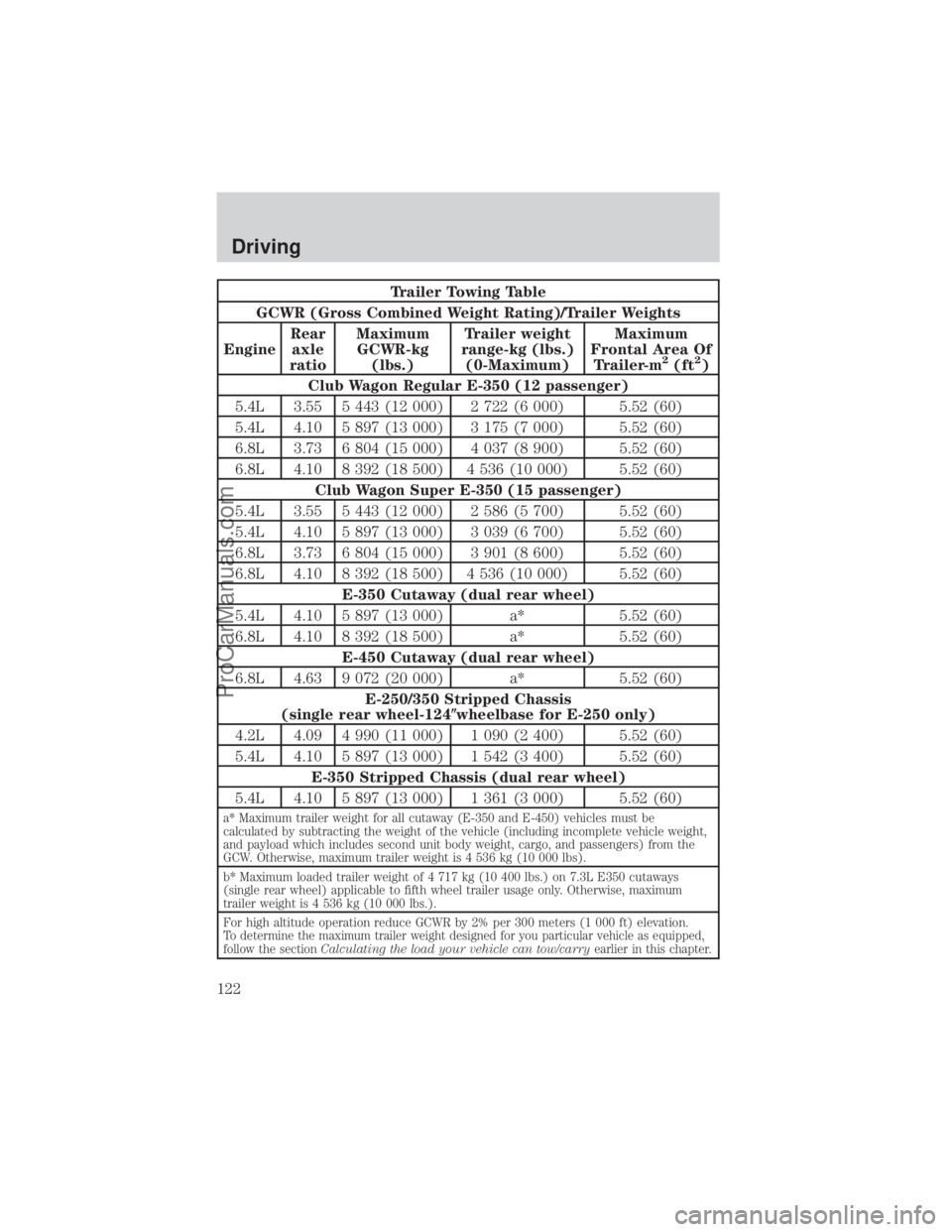
Trailer Towing Table
GCWR (Gross Combined Weight Rating)/Trailer Weights
EngineRear
axle
ratioMaximum
GCWR-kg
(lbs.)Trailer weight
range-kg (lbs.)
(0-Maximum)Maximum
Frontal Area Of
Trailer-m
2(ft2)
Club Wagon Regular E-350 (12 passenger)
5.4L 3.55 5 443 (12 000) 2 722 (6 000) 5.52 (60)
5.4L 4.10 5 897 (13 000) 3 175 (7 000) 5.52 (60)
6.8L 3.73 6 804 (15 000) 4 037 (8 900) 5.52 (60)
6.8L 4.10 8 392 (18 500) 4 536 (10 000) 5.52 (60)
Club Wagon Super E-350 (15 passenger)
5.4L 3.55 5 443 (12 000) 2 586 (5 700) 5.52 (60)
5.4L 4.10 5 897 (13 000) 3 039 (6 700) 5.52 (60)
6.8L 3.73 6 804 (15 000) 3 901 (8 600) 5.52 (60)
6.8L 4.10 8 392 (18 500) 4 536 (10 000) 5.52 (60)
E-350 Cutaway (dual rear wheel)
5.4L 4.10 5 897 (13 000) a* 5.52 (60)
6.8L 4.10 8 392 (18 500) a* 5.52 (60)
E-450 Cutaway (dual rear wheel)
6.8L 4.63 9 072 (20 000) a* 5.52 (60)
E-250/350 Stripped Chassis
(single rear wheel-124(wheelbase for E-250 only)
4.2L 4.09 4 990 (11 000) 1 090 (2 400) 5.52 (60)
5.4L 4.10 5 897 (13 000) 1 542 (3 400) 5.52 (60)
E-350 Stripped Chassis (dual rear wheel)
5.4L 4.10 5 897 (13 000) 1 361 (3 000) 5.52 (60)
a* Maximum trailer weight for all cutaway (E-350 and E-450) vehicles must be
calculated by subtracting the weight of the vehicle (including incomplete vehicle weight,
and payload which includes second unit body weight, cargo, and passengers) from the
GCW. Otherwise, maximum trailer weight is 4 536 kg (10 000 lbs).
b* Maximum loaded trailer weight of 4 717 kg (10 400 lbs.) on 7.3L E350 cutaways
(single rear wheel) applicable to fifth wheel trailer usage only. Otherwise, maximum
trailer weight is 4 536 kg (10 000 lbs.).
For high altitude operation reduce GCWR by 2% per 300 meters (1 000 ft) elevation.
To determine the maximum trailer weight designed for you particular vehicle as equipped,
follow the sectionCalculating the load your vehicle can tow/carryearlier in this chapter.
Driving
122
ProCarManuals.com
Page 123 of 232
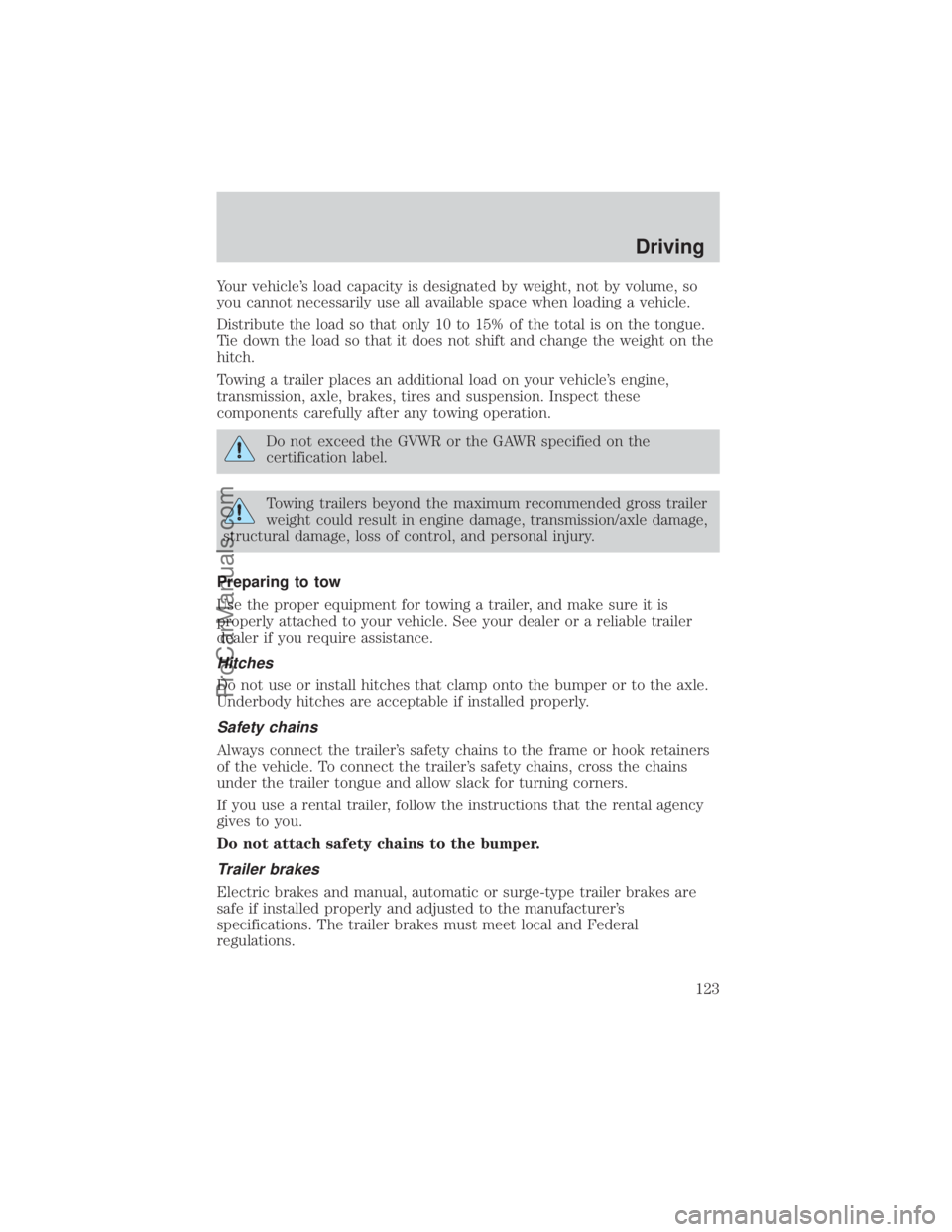
Your vehicle's load capacity is designated by weight, not by volume, so
you cannot necessarily use all available space when loading a vehicle.
Distribute the load so that only 10 to 15% of the total is on the tongue.
Tie down the load so that it does not shift and change the weight on the
hitch.
Towing a trailer places an additional load on your vehicle's engine,
transmission, axle, brakes, tires and suspension. Inspect these
components carefully after any towing operation.
Do not exceed the GVWR or the GAWR specified on the
certification label.
Towing trailers beyond the maximum recommended gross trailer
weight could result in engine damage, transmission/axle damage,
structural damage, loss of control, and personal injury.
Preparing to tow
Use the proper equipment for towing a trailer, and make sure it is
properly attached to your vehicle. See your dealer or a reliable trailer
dealer if you require assistance.
Hitches
Do not use or install hitches that clamp onto the bumper or to the axle.
Underbody hitches are acceptable if installed properly.
Safety chains
Always connect the trailer's safety chains to the frame or hook retainers
of the vehicle. To connect the trailer's safety chains, cross the chains
under the trailer tongue and allow slack for turning corners.
If you use a rental trailer, follow the instructions that the rental agency
gives to you.
Do not attach safety chains to the bumper.
Trailer brakes
Electric brakes and manual, automatic or surge-type trailer brakes are
safe if installed properly and adjusted to the manufacturer's
specifications. The trailer brakes must meet local and Federal
regulations.
Driving
123
ProCarManuals.com